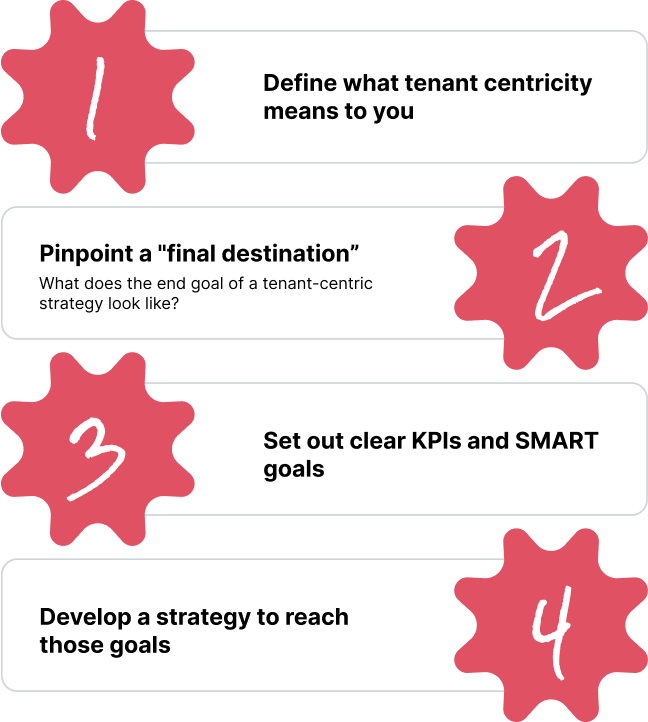How to write a tenant satisfaction survey in 7 steps
Learn how to create a comprehensive tenant satisfaction survey in just seven simple steps. Our guide covers everything you need to know, from...
To successfully transition to a tenant-centric approach in the real estate industry, companies should follow a step-by-step process.

Real estate is undergoing significant changes driven by technology, economics, and societal trends. The focus is shifting towards customer service, with the concept of "living as a service" becoming prevalent.
Modern tenants expect better customer experiences, leading to a transformation in the industry. To thrive in this evolving landscape, real estate companies must embrace innovation and become tenant centric.
In this blog, we take you through the steps needed to making that happen. Let's dive in!
The first step to any successful transition is to get a bird's-eye perspective of the industry you’re in. Observe how it’s changing and what your organisation can do to adapt.
“Behavior is changing. Needs are changing,” says Quintin Schervenels, tech investor and former CEO of Dutch property listing website Funda. “That’s something that is always happening. But a lot of changes are accelerating.”
Schevernels adds that abundance of data allows us to observe shifts in behaviour more closely. “We’re more aware of those changes because we have more data.”
“When I was CEO at Funda, we were able to identify larger trends because we had a lot of data aggregated across the entire housing market. We could see, for example, that during the pandemic searches went up for places outside of the city, especially ones that had a garden or a balcony. We could also see that people were looking for more space to accommodate working-from-home.”
“Data like this is incredibly valuable. It gives you an idea about how people’s needs are changing, and how you can meet those needs.” Data can uncover a lot of micro-changes that are ushered in on the back of larger societal shifts.
In Quintin’s case, the larger societal change was the pandemic, however, on the micro level, the impact was shown through a change in priorities and living preferences observed through user searches.
You can collect data on tenants by running polls and surveys, providing insight into their desires and preferences. On a more quantitative level, residential property management software can help you keep track of engagement rate, responsive times to maintenance requests and other metrics.
For example, Fuzer by Amvest use Chainels to collect data that help enhance the living experience.
“We want to understand whether people actually make use of the common areas and attend activities, whether people communicate with one another via the platform, or whether the key procedures in the tenant experience receive appropriate attention. These are the kind of things we can measure with Chainels.”— Karen van der Ven, General Manager at Fuzer
To become more tenant-centric, real estate companies need to start with a clear vision of what it actually means for their organisation. Developing a vision, and working it into a clear strategy, requires a willingness to think creatively and to experiment with new ideas and approaches.
Define your purpose, and stick with it. This creates a benchmark to know that you're on the right track. To truly make the most of purpose and vision, you need to make sure it's aligned across all aspects of your business.
A transition towards tenant centricity is not just about changing your operations and KPIs. It also requires a transition in the mind of your people. Evaluate how you can utilise talent and transform your organisational structure to better accommodate a tenant centric, service led approach.
“It helps to have a management team that’s intrinsically motivated to innovate and adopt new technologies,” says Frank. “Moreover, they need to communicate that motivation to the rest of the company. They need to show it in their actions—that could be in the form of hiring decisions or the adoption of new technologies.”
Remember that tenant centricity puts the user first. The ‘user’ in this case is the person living in your properties. However, you cannot put that approach into practice if your management team isn’t familiar with it.
“There is a trend of hiring people who focus solely on the customer journey, customer service, or customer success,” says Bert van Lunteren.
“Especially at management and board level, I see many of these mutations happening. The importance of the customer journey is now widely recognized, whereas 10 years ago people were not familiar with the term.”
Beyond management, it’s important to consider how your hiring practices can contribute to or hinder a successful transition to tenant centricity.
Build a culture that prioritises the needs and preferences of tenants by hiring people that approach property management from a customer-centric standpoint.
“If you're really clear on your purpose, that has a magnetising effect of attracting the right people into your business who buy into that ethos because it aligns with their values,” says Kelly Scott.
That may even mean searching for talent outside the industry.
“We’ve already seen growth in community managers coming from the hospitality industry, people who have lots of experience dealing with customers,” says Bert van Lunteren.
“In the coming years, user experience experts may become more important as they can help translate customer needs into the product or service provided. If there are existing employees that have the required skill set, landlords could also invest in training them to focus on tenant’s needs, develop processes that prioritise tenant feedback, and create incentives for employees to deliver a better tenant experience.”
The old way of only looking at direct and indirect returns won’t cut it in 2023. To ensure success, you’ll have to introduce new KPIs into your organisation. You can also use qualitative metrics like tenant satisfaction surveys, online reviews and feedback forms to measure tenant satisfaction and the quality of the living experience.
A common metric companies use to measure user satisfaction is Net Promoter Score. This metric can be applied to residential tenants, too.
Users are typically asked to rate their likelihood of recommending the company or product on a scale of 0 to 10.
Based on the score they give, users are then divided into promoters (9-10), passives (8-7) and detractors (6-0). The number of promoters in relation to detractors is a good indication of how tenants feel about your product and service.
Measuring the strength of your community is difficult since there are no traditional KPIs for building and sustaining strong communities.
But it shouldn’t be overlooked. Sense of community is a strong driver of tenant acquisition and retention. Moreover, it’s great for the general aura and life-quality within your properties.
One way to measure the strength of your community is through engagement.
You can observe tenant engagement by the number of tenants organising and attending events, posting on community message boards, and making use of your property’s amenities.
Engagement signals that tenants see value in the community building tools you’ve put in place, and in your product offering more broadly.
Later down the line, this can translate into positive business outcomes like:
“First, how can we truly understand what our customers want? We should take some time to figure out what data we need, who has it, and whether we need to do any research or surveys,” advises Quintin Schevernels.
Collect and analyse data on tenant demographics, behaviours, and preferences. This can involve conducting surveys, analysing social media data, and tracking building performance metrics.
“It’s easier these days to include the needs of people in what you’re building and that’s largely due to the sheer amount of data that’s available,” says Quintin. “Developers can use that to build properties that better meet the needs of their potential customers.”.
Moreover, landlords and property managers can use data to optimise customer service and living experience within their existing properties where such infrastructures weren’t previously in place.
“Data can help us a lot if it’s used in the right way - it can tell you a lot about what people want and how they behave. And developers and landlords can act upon that. By collecting and using data, we can develop better strategies, improve user experience, and increase business value and yield.”
Once you’ve observed the wider changes happening around you, you should have a clear vision and strategy and along with the necessary data.
Now think about what you need to change and the steps you need to take to get there. Building a roadmap will help you stay focused on what’s important and not get distracted by older ways of doing things.
“List your problems, brainstorm solutions. Rank topics by their impact and implementation costs and create a roadmap, starting with simple steps that provide the most value.”—Quintin Schevernels
Tenant centricity involves more than simply providing a building. It’s about creating living concepts that stimulate social dynamics and encourage empathy.
It goes beyond the ‘bricks’ (the physical environment, standard facilities and hands-off property management) and works to incorporate the ‘experience’ (social dynamics, community management and usership) to create an integrated living experience that meets tenants' needs on multiple levels.
Integrated living concepts are developed with the purpose of improving overall quality of life for residents through community management, services, and a customer-centric approach.
An example of an organisation leading the charge in this area is Fuzer by Amvest.
While real estate as an industry has been slow to embrace a tenant centric approach, Fuzer by Amvest has been something of a trailblazer. They’re a great proponent of integrated living and their properties are truly a proof of concept.
Fuzer manages its communities by catering to tenants' specific needs: gathering feedback while incorporating services and community management into the living experience.
“We call this service-led, community-focused approach ‘integrated living experience’,” says Karin. “To enable this approach, we developed the LIVVIN platform”
LIVVIN is white-labelled tenant communication platform hosted on the Chainels app. Through the platform, Fuzer can organise community events, manage shared spaces and improve communication.
Regular polls and surveys enable them to gather valuable insights from tenants, allowing them to tailor the living experience to each community's unique requirements. By understanding what their residents truly want, they can create an environment that fosters engagement, happiness, and a sense of belonging.
“Loneliness is an issue that Amvest would like to take a role in addressing,” adds Karin. “One way to tackle loneliness is by building communities, so that’s why the LIVVIN concept, and the services and functions enabled by Chainels, is so important to us.”
Amvest embraced technology to help them implement a successful tenant centric approach, and it has paid off.
To successfully transition to a tenant-centric approach in the real estate industry, companies should follow a step-by-step process.
The first step involves using data to observe wider trends in the industry and identify areas where adaptation is needed. Metrics like Net Promoter Score and tenant satisfaction surveys are essential in measuring tenant experience and satisfaction. Additionally, assessing community strength through tenant engagement indicators is crucial for tenant acquisition and retention.
The next step is to develop a clear vision and strategy for becoming tenant-centric. This involves setting goals, defining metrics for success, and aligning the organisation with the purpose of providing better living experiences for tenants.
Hiring and training employees with a customer-centric mindset is essential to prioritise tenant needs and preferences. Organisational structure should be adjusted to accommodate the shift towards tenant-centricity, potentially creating specialised departments to focus on tenant-related work.
Learn how to create a comprehensive tenant satisfaction survey in just seven simple steps. Our guide covers everything you need to know, from...
Discover 6 fun and thoughtful tenant appreciation event ideas that foster community and boost tenant retention. From "Yappy Hour" to dinner delivery,...
Discover how access control systems and digital locks revolutionise real estate security. Explore types, benefits, integration, and requirements for...